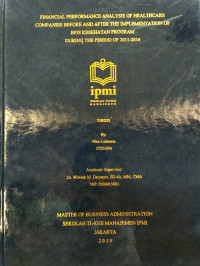
Financial Performance Analysis Of Healthcare Companies Before And After The Implementation Of BPJS Kesehatan Program During Of 2011-2016
| Gmd : Text
| Availability :
| 2019579 | 579 | IPMI Kalibata (THESIS S2) | Available |
In May 2016 World Health Organization (WHO) published the list of countries by life expectancy. In the period 2010 until 2015, the average world's life expectancy at birth was 71 years old, with 70 years old for males and 72 years old for females. In this list showing that Indonesia was in the list number 120 in the world from 183 countries and number 6 in the Association of South East Asian Nation (ASEAN) with average life expectancy at 69.1 years old, with 67.1 years old for male and 71.2 years old for female. In 2019 the US Census Bureau released the latest list of countries by life expectancy showing that Indonesia falls in position number 130 but increasing in the life expectancy number with the average number in 71.5 years old, 69.4 years old for male and 73.8 years old for female. This showing that some factors that directly effecting the numbers, such as the standard of living and the quality of healthcare facilities are increasing. In January 2014, the Indonesia government launch the National Health Insurance (JKN) through their Social Insurance company owned by the government (BPJS) to provide health insurance for all Indonesia citizens. This program will cover all the hospital expenses that emerge from the use of hospital services by the citizen so it will lighten up the live load for the poor and unfortunate citizens. On its way to the implementation of the Program there were payment arrears from the government to the hospitals. This study intends to analyze the financial health condition before and after the implementation of the JKN program of three hospitals in the Healthcare industry; 1) Mayapada Hospital; 2) OMNI Hospital; 3) Siloam Hospital. The result of the observation of the financial ratio obtained from audited financial reports is then checked by the decree establishing their financial health status. Using a specific period from 2011 until 2016, the study will analyze before the implementation of JKN (2011-2013) and after the implementation (2014-2016). It's showing that the implementation of the JKN affecting the financial performance of the hospitals. As shown in their annual report, the Mayapada Hospital and the OMNI Hospital were having a significant effect on their ROA and ROE, while Siloam Hospital not effected but showing slow but sure declining numbers. As for the ROI, it was not affected significantly but still, there is a fluctuation every year with a tendency on decreasing of the numbers.
Keyword: ROE, ROI, ROA, Healthcare industry, Financial Health Status
| Series Title |
-
|
|---|---|
| Call Number |
579
|
| Publisher Place | Jakarta |
| Collation |
42p; 30cm
|
| Language |
English
|
| ISBN/ISSN |
-
|
| Classification |
579
|
| Media Type |
-
|
|---|---|
| Carrier Type |
-
|
| Edition |
-
|
| Subject(s) | |
| Specific Info |
-
|
| Statement |
-
|
| Content Type |
-
|
No other version available







